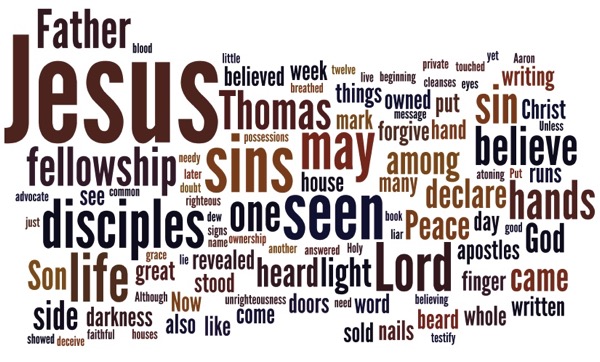2 Easter
The disciples have all things in common, but bear testimony not to their lifestyle; they are one in heart and mind, but speak not of inner peace and collective harmony. They garner great virtue and give evidence of grace, but give no self-congratulating confession (Acts 4:32). Rather, they “testify to the resurrection of Jesus Christ” (Acts 4:33). For it is in the grip and power of Christ’s resurrection that they are compelled to give to each according to need, and to feel and know that the heart and mind of one is a matter of concern to all.
They are in the orbit of this power; their gaze is turned to it. Indeed, all their senses awaken to Christ the Risen One. A lesson begins with a sentence that begins with these words: “We declare to you.” The conventions of a modern English translation, however, have been untrue to our text; the truth is tucked away in the safe cover of the Authorized Version: “That which was from the beginning, which we have heard, which we have seen with our eyes, which we have looked upon …. We have seen, and bear witness, and declare to you that eternal life which was with the Father and was manifested to us — that which we have seen and heard we declare to you, that you also may have fellowship with us; and truly our fellowship is with the Father and his Son Jesus Christ” (1 John 1:1-3 NKJV).
Before public proclamation, there is seeing with eyes to see, touching with hands to touch, hearing with ears to hear; a deep sensory encounter with Christ so magnificent and overwhelming that it raises the disciples to communion with the Father, which they experience through their communion with the Son. They proclaim the Risen One whom they know and the communion he gives and the joy that is complete only as Christ’s new life goes out to the ends of the earth (John 1:4).
Is there another way to know Christ, to know without seeing and touching and hearing? A story is told. Jesus appears to the disciples and greets them in the narrative present: “Peace be with you” (John 20:19b). Before the greeting, he arrives and stands among them. He is there, alive and yet still bearing his body broken. His brow is bruised, his hands and feet pierced, his side split open, his back marred and ripped. The disciples see and believe. But not Thomas; he is not there.
Hearing the report of the appearance, Thomas says: “Unless I see the mark of the nails in his hand, and put my finger in the mark of the nails and my hand in his side, I will not believe” (John 20:25). So, appearing again, Jesus invites Thomas to reach and touch. Thomas believes because he sees. Jesus says this: “Blessed are those who have not seen and yet have come to believe” (John 20:29). The second, third, and forth generation of Christian disciples never heard the tone of Jesus’ voice, never felt his human hand, never looked upon the visage of the God-man.
He is, to be sure, in the mind and heart. But he is, no less, where the holy water is, the unctuous olive, the board of bread and word, the joining of hands, a priest forever, a sin repented, a pall put to a coffin: embodied wherever he wills to be.
And he wills to be in our creation, preservation, and all the blessings of this life, and especially the redemption of the whole circle of the languishing lands.
Look It Up
Read Psalm 133.
Think About It
Use the oil of gladness. Let it run from your face to your robe. Can you feel the everlasting?
 TLC on Facebook ¶ TLC on Twitter ¶ TLC’s feed ¶ TLC’s weblog, Covenant ¶ Subscribe
TLC on Facebook ¶ TLC on Twitter ¶ TLC’s feed ¶ TLC’s weblog, Covenant ¶ Subscribe









